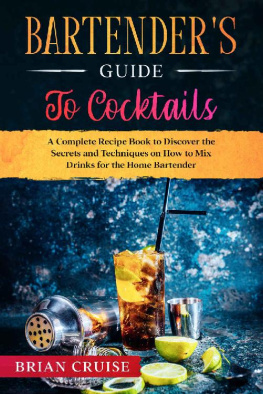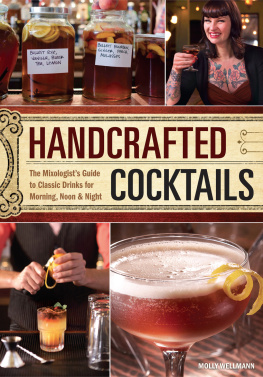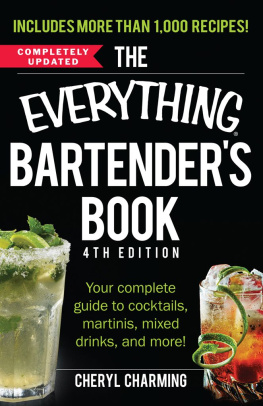Bartenders Guide to Cocktails
A Complete Recipe Book to Discover the Secrets and Techniques on How to Mix Drinks for the Home Bartender
Brian Cruise
Text Copyright [Brian Cruise]
All rights reserved. No part of this guide may be reproduced in any form without permission in writing from the publisher except in the case of brief quotations embodied in critical articles or reviews.
Legal & Disclaimer
The information contained in this book and its contents is not designed to replace or take the place of any form of medical or professional advice; and is not meant to replace the need for independent medical, financial, legal or other professional advice or services, as may be required. The content and information in this book has been provided for educational and entertainment purposes only.
The content and information contained in this book has been compiled from sources deemed reliable, and it is accurate to the best of the Author's knowledge, information and belief. However, the Author cannot guarantee its accuracy and validity and cannot be held liable for any errors and/or omissions. Further, changes are periodically made to this book as and when needed. Where appropriate and/or necessary, you must consult a professional (including but not limited to your doctor, attorney, financial advisor or such other professional advisor) before using any of the suggested remedies, techniques, or information in this book.
Upon using the contents and information contained in this book, you agree to hold harmless the Author from and against any damages, costs, and expenses, including any legal fees potentially resulting from the application of any of the information provided by this book. This disclaimer applies to any loss, damages or injury caused by the use and application, whether directly or indirectly, of any advice or information presented, whether for breach of contract, tort, negligence, personal injury, criminal intent, or under any other cause of action.
You agree to accept all risks of using the information presented inside this book.
You agree that by continuing to read this book, where appropriate and/or necessary, you shall consult a professional (including but not limited to your doctor, attorney, or financial advisor or such other advisor as needed) before using any of the suggested remedies, techniques, or information in this book.
Table of Contents
Introduction
A bartender refers to somebody who serves drinks behind an approved bar to paying patrons. A bartender can additionally be referred to as a barmaid or a barkeep. Bartenders are located in bars, pubs, taverns, clubs and other such locations.
The bartender blends and serves beverages, and most of the beverages a bartender is making consist of alcohol, like beer, wine, liquor, coolers and mixed drinks. They likewise serve water, juice, pop and other non-alcoholic drinks for individuals who do not want to consume alcohol like an appointed driver or a non-drinker.
In addition to creating and serving beverages, the bartender is likewise responsible for taking payment for beverages (either from consumers, waiters or waitresses), maintaining the alcohol supplies and glasses stocked, maintaining the bar area tidy, preserving plenty of ice and garnishes on hand and serving food to patrons sitting at the bar, in case the bar provides food for sale. Typically, the bartender is expected to dress properly to contribute to the environment of the bar. In some facilities, the bartender may take part in flair bartending, which adds to the entertainment in the bar.
Bartenders are counted on to be equipped to mix numerous kinds of drinks to satisfy any paying customer in a fast, precise and non-wasteful style. In some facilities, like a hectic club, the bartender is just expected to serve the customer a beverage and absolutely nothing else. In a tinier location such as a pub, however, the bartender may be counted on to be an excellent listener, and permit the customers to have a shoulder to weep on.
All bartenders must be friendly, nevertheless, and delight in having contact and interaction with individuals. Great bartenders have a method of drawing in regular customers. Great bartenders like this are going to remember the preferred beverage of frequent customers; have beverage recommendations handy or recommendations for other bars, in addition to numerous other informal tasks. In a lot of countries , tipping is assumed of the customer, and this is how the bartender gets most of his earnings, as many bartenders are paid minimum wage. In some locations, minors are allowed in bars, and it is the bartender's duty to look for identification prior to offering them alcohol.
If this seems like a great deal of work, with very little reward, look on the bright side. You are operating at a facility that serves gallons of alcohol every day, and you supervise it. The task of a bartender is management, customer care, and so much more! Even a bartending job appears great on a resume when you demonstrate it in the correct way!
Before you begin to tend bars-- whether it's as a job or in your own house, an excellent grasp of terms could be a terrific resource.
Glassware Guide
Today you can find glassware in an almost infinite number of designs, colors, shapes, and purported functionalities. To help you begin to sort through the multitude, this section explains the glassware that is named in the cocktail recipes that follow.
Because this is a practical guide, we have grouped the glassware into three categories: essential, advanced, and optional. Though having a wide range of serving vessels available gives your bar a certain je ne sais quoi, it is absolutely not necessary.
That said, in drinking, presentation plays a key role in determining whether you will enjoy a beverage. Drinks served in beautiful glassware or bottles are often perceived as being of higher quality, a phenomenon known within the industry as drinking the label. Although it is unclear whether the glassware makes a measurable scientific difference in taste, it does impact the experience.
On a more practical level, some glasses do what they are designed to do. These vessels keep a hot drink hot, enhance the aromatics of a Cognac or wine, or even preserve some of the carbonation in a sparkling wine.
The illustrations that accompany each drink are the most recognizable versions of these glasses. Further, the capacity listed with each glass is the ideal for use with cocktails. To make sure your drinks stay cold, chill the glasses unless the cocktail is served over ice.
As previously stated, although this list is rather hefty, not every piece is absolutely essential. Realistically, to start making cocktails, use whatever you have on hand. When you start building your home bar, you really need only six or eight of each type of glass.
When one is a bartender, it is important to choose the appropriate glass for each specific drink they serve. Utilizing different glasses entice customers by enhancing the appearance of the cocktail.
Bartending glassware is used for the different drinks bartenders create. These may vary according to size, shape, color, and what not. Each kind of glass has each different purpose when it comes to style and can even influence the taste of the cocktails. Bartending glassware for bartenders is one way to represent different beverages and cocktails when these are mixed.
Types of Glassware
Beer Mugs
As the name implies, beer is the most common beverage ordered inside the bar. It is a typical glass mug with a handle that is designed for serving beers, frozen cocktails, coffee based cocktails and all cocktails that are beer-based. Usually, beer mugs can hold approximately 12-16oz.
Rock Glass
Basically, people who use terms inside the pub like "on the rocks" are not new to the habit of drinking. However, for people who have just started drinking, this term is actually referring to a rock glass and referred to as an old-fashioned glass. Individuals who love to drink gins or whiskeys usually use this kind of glass.
Next page







